Haryana State Board HBSE 8th Class Science Solutions Chapter 1 Crop Production and Management Textbook Exercise Questions and Answers.
Haryana Board 8th Class Science Solutions Chapter 1 Crop Production and Management
HBSE 8th Class Science Crop Production and Management Textbook Questions and Answers
Question 1.
Select the correct word from the following list and fill in the blanks:
Float, water, crop, nutrients, preparation
(a) The same kind of plants grown and cultivated on a large scale at a place is called …………… .
(b) The first step before growing crops is …………… of the soil.
(c) Damaged seeds would …………… on top of the water.
(d) For growing of crop, sufficient sunlight and …………… and …………… from the soil are essential.
Answer:
(a) Crop
(b) preparation
(c) float
(d) water, nutrients.
Question 2.
Match items in column ‘A’ with those in column ‘B’:
| (A) | (B) |
| (i) Kharif crops | (a) Food for cattle |
| (ii) Rabi crops | (b) Urea and super phosphate |
| (iii) Chemical fertilisers | (c) Animal excreta, cow dung, urine and plant waste |
| (iv) Organic manure | (d) Wheat, gram, pea |
| (e) Paddy and maize |
Answer:
| (A) | (B) |
| (i) Kharif crops | (e) Paddy and maize |
| (ii) Rabi crops | (d) Wheat, gram, pea |
| (iii) Chemical fertilisers | (b) Urea and super phosphate |
| (iv) Organic manure | (c) Animal excreta, cow dung, urine and plant waste |
Question 3.
Give two examples of each:
(a) Kharif Crop
(b) Rabi Crop
Answer:
(a) Paddy and maize
(b) Wheat and gram
![]()
Question 4.
Write a paragraph in your own words on each of’the following:
(a) Preparation of soil (b) Sowing (c) Weeding (d) Threshing.
Answer:
(a) Preparation of Soil:
Soil is prepared to sow the seeds. It is tilled to loosen the soil particles for better absorption of water and manures. Loosening of soil particles add humus and nutrition to the soil for better crops. Tilling of soil is done by using ploughs which are pulled by bulls. Tractor driven cultivators are also used to till the soil.
(b) Sowing:
Sowing means implanting the seeds in the prepared soil. Seeds are first selected. Better and healthy breeds of seeds are selected. They are then sowed in the fields with the help of seed drills and funnel shaped tools. The funnel, has a long body on one end of which is placed in soil. Seeds are put in the funnel and seeds go into the soil through long pipe which is carried over in the field with help of ploughs, the lower end pierces through the soil, spreading the seeds. Some seeds are simply spread through the field by hand. Some saplings are planted directly in the field manually.
(c) Weeding:
Unwanted plants growing along the crop are called the weeds. These weeds absorb the nutrients from the soil which are ment for the crops. They are, therefore, removed from the fields. Weeds are either removed manually or by mechanical tools. Certain chemicals are also used to kill the unwanted plants growing in the crops.
(d) Threshing:
Separation of grains from the chaff is called threshing. Seeds are removed from the chaff by threshers. When the crop is harvested, it is cut alongwith the stalks. They are then separated and the grains are removed. This whole process takes place with the help of a huge machine called combine.
Question 5.
Explain how fertilisers are different from manure.
Answer:
Differences between fertilizers and manure:
(i) Fertilisers are chemical substances, while the manures are the organic substances.
(ii) Fertilisers are prepared in the factories while the manures are prepared in fields.
(iii) Fertilisers don’t provide any humus to soil while manures provide a lot of humus.
(iv) Fertilisers are rich in plant nutrients will manures are less rich in plant nutrients.
Question 6.
What is irrigation? Describe two methods of irrigation which conserve water.
Answer:
Watering the crops in the fields is called irrigation. Irrigation is done at different intervals. Irrigation should be done in a way in which water does not get wasted, two such methods which conserve water are:
(i) Sprinklers:
Sprinklers work like fountains. Long perpendicular pipes have holes at regular distances, when water is supplied, it comes out of these holes and spray water in field. These holes have rotating nozzles which sprinkle water in all directions. Limited outflow of water, controls wastage of water.
(ii) Drip System:
This system allows the water to flow drop by drop at the roots of the plants. It contains a main pipe which have further lateral pipes containing small nozzles for the outflow of the water. Nozzles are such placed that they throw water at the roots of the plants, which saves water from flowing around uselessly.
Question 7.
If wheat is sown in kharif season, what would happen? Discuss.
Answer:
If wheat are grown in Kharif season, they would not grow as they do not need ihuch water to grow. The seeds would get destroyed in excess water due to rainy season.
Question 8.
Explain how soil get affected by the continuous plantation of crops in a field.
Answer:
Continuous plantation of crops drains off the nutrients of the soil. It leaves the land unfertile and unable to bear crop. It does not give any time to the soil to replenish the absorbed nutrients by the crops, thus unable to sustain any further healthy and good crop.
![]()
Question 9.
What are weeds V How can we control them?
Answer:
Weeds are the unwanted plants growing along crops. They share the nutrients meant for plants and thus are harmful. We can control weeds with the help of chemicals called weedicides. Weeds are the unwanted plants growing along the main crops. They are either removed manually or by chemicals. Weedicides are sprayed in the fields to kill the unwanted plants. These weedicides do not affect the main crop. Weeds are removed or killed during their vegetative phase before flowering or bearing seeds.
Question 10.
Arrange the following boxes in proper order to make a flow chart of sugarcane crop production:

Answer:

Question 11.
Complete the following word puzzle with the help of clues given below:
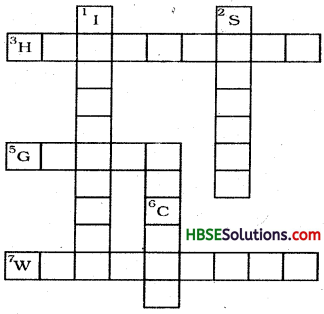
Down
1. Providing water to the crops.
2. Crop grains have to be kept for a long time in proper conditions.
5. Certain plants of the same kind grown on a large scale.
Across
3. A machine used for cutting the taatured crops.
4. A rabi crop that is also one of the pulses.
6. A process of separating the grain from chaff.
Answer:
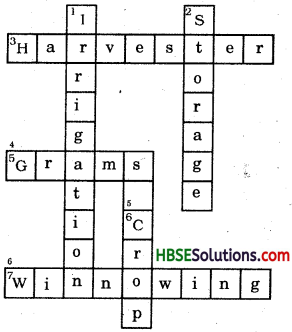
Activity 1.3
| Food | Sources |
| 1. Milk | Cow, Buffalo, She-goat, She-camel |
| 2. Cereals grains | Plants like wheat, rice |
| 3. Meat | Goat, Cow, Hen, Fish |
| 4. Vegetables | Plants like brinjal, potatoes, tomatoes, etc. |
Extended Learning – Activity And Projects
Question 1.
Sow some seeds in the soil and arrange to water them by drip irrigation. Observe daily.
(i) Do you think it can save water?
(ii) Note the changes in the seed.
Answer:
(i) Yes, drip irrigation saves water as it doe not allow the water to flow on sides and get wasted.
(ii) Seeds slowly get germinated.
Question 2.
Collect different types of seeds and put them in small bags. Attach these bags in a herbarium file and label them.
Answer:
Do it yourself.
![]()
Question 3.
Collect new agricultural machine pictures and paste in a file with their names and uses.
Answer:
Tractor to drew ploughs and carriage combines for threshing.
Plough for tilling soil.
Winnowing machine for removing chaff.
4. Project Work: Visit a farm, nursery or a garden nearby. Gather information about:
(i) importance of seed selection
(ii) method of irrigation
(iii) effect of extreme cold and extreme hot wather on the plants
(iv) effect of continuous rain on the plants
(v) fertilisers / manure used.
Answer:
(i) Good seed give good crops.
(ii) Traditional and modern
(a) Traditional: Moat, Chain pumps, Dhekli and Rahat
(b) Modern: Drip irrigation and Sprinklers.
(iii) Extreme cold and heat destroy the crops.
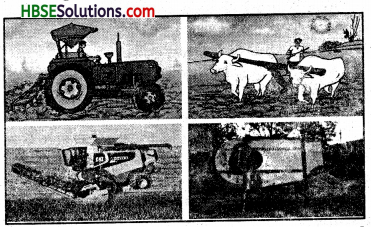
(iv) → Continuous rain get plants decomposedand waer logged in fields.
→ Minerals and fertilisers get flown away.
→ Top fertile layers get destroyed.
(v) Enhance the productivity of soil.
For more information, visit:
- www.krishiworld.com / html / balanced fertiliser.htm.
- www.ikis.com / links / ap.cultivation.html.
HBSE 8th Class Science Crop Production and Management Important Questions and Answers
Very Short Answer Type Questions
Question 1.
Why do every living organism need food?
Answer:
Every living organism needs food to grow and perform various other activities and body functions.
Question 2.
Where do we get our food from?
Answer:
We get our food from plants and animals.
Question 3.
What is agriculture?
Answer:
Growing and managing crops is called agriculture.
Question 4.
What is crop?
Answer:
When same type of plants are grown at a large scale, it is called crop.
Question 5.
Name the factors controlling crop production.
Answer:
Soil, water, sunlight and air.
Question 6.
What are the rainy season crops called?
Answer:
Kharif crops.
![]()
Question 7.
What are the summer season crops called?
Answer:
Zayed crops.
Question 8.
What are the winter season crops called?
Answer:
Rabi crops.
Question 9.
Name any three Kharif crops.
Answer:
Paddy, maize, cotton.
Question 10.
Name any three Rabi crops.
Answer:
Wheat, gram, mustard.
Question 11.
Name any three Zayed crops.
Answer:
Moong, musk melon, bitter gourd.
Question 12.
What is tilling?
Answer:
Tilling is the loosening and turning of the soil.
Question 13.
What are crumbs?
Answer:
Crumbs are big pieces of soil present in fields, which require tilling.
Question 14.
Which agricultural tools are Used for tilling?
Answer:
Plough, hoe and cultivators.
Question 15.
Name tools used for sowing.
Answer:
Funnel shaped pipe with plough and seed drill.
Q. 16.
What is transplantation of seeds?
Answer:
Small saplings of plants are directly plantedj in fields. This is called transplantation.
![]()
Question 17.
What are fertilizers and manures?
Answer:
Manures and fertilizers are the substances added to soil to enhance its fertility and nutrients.
Question 18.
Which manure is called organic manure?
Answer:
Manure obtained from the dead bodies of plants and animals.
Question 19.
Name any two important fertilizers.
Answer:
Urea, NPK (Nitrogen, Phosphorus, Potassium).
Question 20.
What is a fallow?
Answer:
An uncultivated field between two croppings is called a fallow.
Question 21.
Write sources of irrigation.
Answer:
Wells, tubewells, ponds, lakes, rivers, dams and canals.
Question 22.
What is harvesting?
Answer:
Cutting of the crop after it is mature is called harvesting.
Question 23.
What is threshing?
Answer:
Separating seeds from the chaff is called threshing.
Short Answer Type Questions
Question 1.
What do you mean by agriculture?
Answer:
The term agriculture is derived from the Latin words ‘Ager’ which means field and ‘culture’ which means cultivation. Thus, cultivation in fields means agriculture.
Question 2.
Write the names of various agricultural practices undertaken to produce a crop.
Answer:
Following agricultural practices are performed to produce the crop:
1. Soil preparation
2. Sowing
3. Adding manure and fertilizers
4. Irrigation
5. Protection from weeds
6. Harvesting
7. Storage.
![]()
Question 3.
How many categories of crops are sown in India based on the seasons?
Answer:
Three categories of crops are sown in India based on the seasons:
(i) Kharif crops are sown during rains.
(ii) Rabi crops are sown during winters, and
(iii) Zayed crops are grown during summers.
Question 4.
Why is the $oil turned and loosened before seeds are sown?
Answer:
The soil is turned and loosened during the process of ploughing. The ploughing loosens the soil particles and turn the soil of upper
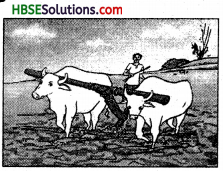
surface. This allows the nutrients from the dead organism to be released back in the soil and better penetration and absorption of nutrients by plant roots.
Question 5.
What are manures and fertilizers?
Answer:
Manures and fertilizers are used to enhance the productivity and fertility of the field. Manure is made of waste products of animals and plants. Fertilizers are chemicals rich in nitrogen, potassium.
Question 6.
What is the role of water in production of crops?
Answer:
Water is essential for all plants. Crops should get enough water at different stages of their growth. Different crops require different amount of water in the field. The wheat crop requires moderate amount of water at the time of sowing, flowering and ripening of crop.
Therefore, corps should be irrigated properly according to their needs.
Question 7.
What are the different methods of irrigation?
Answer:
Different methods of irrigation are adopted according to the requirement of soil and size of the field. Some common methods of water supply are through small channels, which get water from tubewells and canals, lift irrigation, sprinkler, dripping irrigation, etc.

Question 8.
Define weeding. What tools are used for weeding?
Answer:
Weeds are unwanted and undesirable plants which grow alongwith the crop plants in the field. They grow rapidly than the crop plants and cause harm to them. It is, therefore, essential to remove weeds at proper time. The process of removing the weed plants is called weeding. It is done either by hand or by khurpi. It is also done by spraying chemicals or weedicides.
Question 9.
What is humus? How is it formed?
Answer:
Humus is a kind of soil rich in nutrients. It is formed by the microbial action on dead decaying bodies and leaves. It is generally formed on those spots where-there are dense layers of trees. The soil below it becomes dark having more number of pathogenic bacteria.
Question 10.
What are pesticides?
Answer:
The chemicals which are used to protect crops from the organisms called pests are known as pesticides. They are used to kill eggs and larvae of insects who could cause harm to the crops. Pesticides are sprayed in the fields by different methods at different intervals.
![]()
Question 11.
What safety measures are to be taken in handling pesticides and weedicides?
Answer:
Insecticides and pesticides are highly poisonous chemicals. They kill the pests. They can harm the humans also. So, certain precautionary measures should be taken while spraying pesticides and weedicides.
They should be kept away from the reach of children.
They should not be inhaled while spraying. Gloves and mouth covers should be used while spraying them.
Hands should be washed properly after their use.
Question 12.
Distinguish between pesticides and weedicides?
Answer:
Weeds are controlled by using certain chemicals called weedicides. These chemicals do not cause any damage to the crop.
Pesticides are the chemicals which are used to kill the pests growing on the crops. They kill the eggs and larvae of the insects.
Question 13.
Explain the process of harvesting?
Answer:
The removal of crop after maturity is called harvesting. The harvesting is done manually with the help of ordinary sickles in crops like wheat, paddy and maize. Even tractor driven machines are also used for harvesting wheat and paddy. Fruits and vegetables are plucked manually.
Question 14.
Explain the process of threshing,
Answer:
The crops need to be threshed to separate grains from the chaff. The mechanical harvesters help in both threshing and separating the grains. The small farmers thresh their crops by spreading the crops on the ground and walking of animals over it. Now-a-days threshing is done by threshing machines driven by tractors or electric motors, which separate grain from chaffs.
Question 15.
What factors influence the crop production?
Answer:
The factors that influence the crop production are as follow:
(i) “Soil: It is the upper layer of earth’s crust. It is the natural medium which supports plant growth.
(ii) Water: Plants require water during various stages of their growth and development such as germination, flowering, ripening, etc.
(iii) Air: Air is essential for breathing and photosynthesis.
(iv) Sunlight: It is essential for plants as a major promotion factor for photosynthesis, germination and flowering.
Question 16.
Suggest ways for the improvement of crops.
Answer:
Following ways should be adopted to improve the crops:
(i) Use of improved seeds.
(ii) Improve fertility of soil.
(iii) Protection against pests and weeds.
(iv) Better transport and storage facility.
(v) Introduction of high yielding varieties of seeds.
![]()
Long Answer Type Questions
Question 1.
What are some basic principles of crop production?
Answer:
There are certain conditions which are very important for causing the good crop yield. Good and right kind of soil, seeds, water and protection of crops from weeds and pests as well as the use of proper implements and practices- all go to determine the quality and reliability of crop yield.
A field or farm needs to be managed properly in order to get better yield. Farmers, therefore, must observe some important things which are listed below:
(i) The crop field should be open so that sunlight and air are abundantly available.
(ii) The field should be protected from stray cattle and tresspass which may destroy the crop.
(iii) The soil should be loosened and turned before sowing so that the plant roots can penetrate into it easily and are well ventilated. The latter helps in holding the plant firmly. Root and tuber crop plants need loosened soil for proper growth of the plant product.
(iv) The right amount of water should be available neither too less nor too in excess.
(v) The soil should contain sufficient nutrients for the growth of the plants.
(vi) The unwanted plants such as weeds should be removed from the soil. These weeds compete with the main plants and deprive them of their nourishment.
Question 2.
What is the use of soil for the plants?
Answer:
Soil plays an important role in agriculture in following ways:
(i) Soil fix up the plant in the soil. It holds the roots firmly and anchor the plant.
(ii) Soil has the power of retaining the water which helps the absorption by plants. It also contains minerals etc. which provides food nutrients to the plants.
(iii) It also provides space for living to useful animals such as earthworms which turn up soil and make it fertile.
(iv) Soil holds air in its gaps. This air is used by the plant for its respiration as well as for the respiration of the useful plants and bactria.
Question 3.
How are pests controlled in a crop field?
Answer:
Pests are the organisms smaller bugs which damage the crop plants in the field, during transportation, in the godowns. The common pests are birds, rats and other rodents, some animals, insects and micro-organisms belonging to different groups. They are harmful as they destroy the crop. Pests like locusts, beetles, red spiders, aphids, etc. can be controlled by three methods.
(i) Chemical control: The use of pesticides like DDT, malathion, BHC and aldrin. These chemicals are quick and effective way of controlling the growth of the pests.
(ii) Biological control: One insect feeds von other insect. In this method harmless insects are introduced in the field which will be harmful for insects and other pests.
(iii) Growing pests resistant varieties: Breeding crop varieties which are resistant to pests is a very effective and common method of pest control.
Question 4.
Why do we irrigate our crops? Explain.
Answer:
Water is required by the plants for the following activities:
(i) The seeds sown in the soil absorb water for various activities related to germination, such as activation of phenul, radicle and embryonal axis.
(ii) Water is essential for softening of soil particles so that the roots may penetrate deeply into the soil easily.
(iii) The mineral salts, manure particles, etc. dissolve in water and make the dilute solution. It is easily absorbed by the root hair.
(iv) Water is essential to maintain the turgidity of the cells and to keep them inactive form.
(v) Water is evaporated from the soil as well as from the aerial parts of the plants. Irrigation is essential to fill up the loss of water.
(vi) For the preparation of food by the plants through the process of photosynthesis, water is very essential.
Question 5.
Why an earthworm is called a friend of a farmer?
Answer:
Before sowing seeds every farmer prepares his soil for sowing. He digs the soil. He does tilling with help of tractors and ploughs. This all is done to loosen the soil particles so that air .and nutrients can be easily absorbed. Earthworm is an organism which lives under the soil and make burrows for itself. This burrowing action loosens the soil for better penetration of roots of the crops.

It create channels through the field which improves the physical properties of the soil. The burrowing action of earthworm improves soil structure, helps in formation of humus mix and till the soil and increase the supply of nutrients of the plants.
![]()
Question 6.
Write a short note of thresting and winnowing.
Answer:
When a farmer cut his crops, he has to separate the grains from the crop it is done in two ways. Manually and with machines.
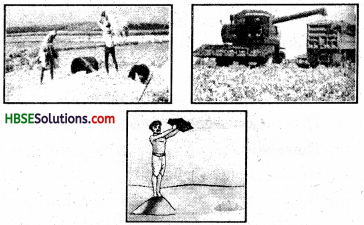
The separation of seed from the crops by beating out the seeds (grain) from the crop is called threshing. It is done manually or by using threshers with combines.
After separating the grain from the harvested crop, it is required to separate grain from chaff. This process is done by winnowing. The grains are thrown from the height in the direction of air. The air carries away the lighter chaff or dried stems and leaves and the heavier grains drop down in form of a heap. This whole process is called winnowing.
![]()
Crop Production and Management Class 8 HBSE Notes
1. All living beings need food to live and perform various other activity.
2. We get food from plants and animals. The plant food is grown in fields making use of various processes. This is called agriculture.
3. All plants of same types grown together are called crops. Different types of crops are grown in the fields e.g. cereals (wheat, paddy rices) fruits and vegetables, etc.
4. Based on seasons many crops are grown. Rainy season crops are called Kharif. Winter crops are called Rabi and Summer crops are called Zayed crops.
5. To grow a crop a number of activities has to be performed. These are called agricultural practices. These agricultural practices include: soil preparation, sowing, adding manure and fertilizers, irrigation, protection from weeds, harvesting, storage, etc.
6. Preparation of soil includes loosening soil. This is called tilling or ploughing. Plough, cultivator and hoe are used as tools.
7. Sowing means putting the seeds in the loosened ground to grow.
8. For a healthy and good crop manure and fertilizers are added to the crop. These are chemicals which enhance the crop production.
9. When we grow crop in the field it takes all the nutrition away from the soil. This nutrition is – required for the next crop. The soil is replenished with nutrition by these fertilizers and manures. Crop-rotation is another method of replenishing nutrition in soil.
10. Crops are watered sufficiently by canals, drips and rainwater. This is called irrigation of crops. Irrigation is the most important process of crop production.
11. Undesirable plants growing among the crops are removed manually or by machines. These unwanted plants are called weeds, chemicals used to kill weeds are Called weedicides.
12. Sometimes some small animals start eating the crops. These are called pests. Special chemicals
are sprayed on the crops to kill the pests. These chemicals are called pesticides.
13. After the crops are ready, they are harvested. Grains are separated from the chaff. This process is called threshing. Threshers are used to do this process.
14. The harvested grains are then Stored in huge stores, after they are properly dried in sun. These stores kre called granaries.
15. We also get our food from animals. For this purpose some useful animals are domesticated
and reared. This is called Animal Husbandry. Animals like cows, buffaloes, goats, hens etc. are domesticated for food.